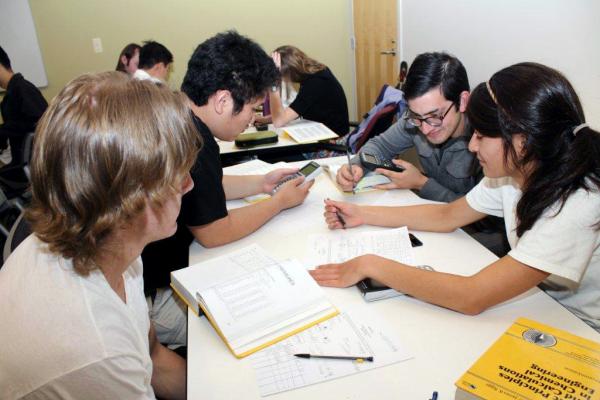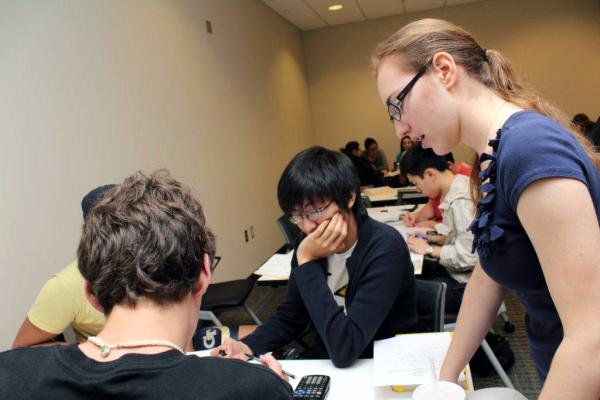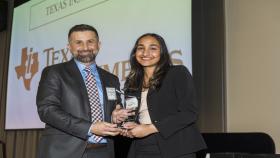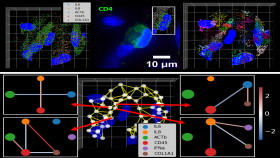Peer through the narrow window into Room 1232 Whitaker, and you’ll see what appears to be a typical college class: professor talking, students listening, whiteboards.
But if you were inside the room, you’d find that this class is anything but typical.
The students sit in pairs, facing each other, four to a table. The instructor, Maysam Nezafati, is not lecturing; he’s demonstrating a problem. Teaching assistants walk the room, depositing desk blotter pads onto the tables. Notebooks and laptops aren’t allowed — each student tandem must tackle Nezafati’s problem on the giant pads.
Welcome to the spring semester session of BMED 2210, an early course in biomedical engineering where students apply material and energy equations to address real-life situations.
Solving problems is foundational to engineering courses, but the “Problem Solving Studio” approach taken in BMED 2210 is somewhat revolutionary. In a traditional lecture class, the professor talks and models equations, then sends the students off to try it on their own. Conversely, nearly all class time in the Problem Solving Studio (PSS) is spent team-tackling complex problems with little or no previous instruction on how to do so. By using the requisite desk blotter pads, the students must present not only their solution but also how they arrived at it.
“The power of this environment is that the students learn by doing, in public, and in cooperation with their peers,” says Joe Le Doux, an associate professor of biomedical engineering who created the PSS method. “And because the work is done in the open, the instructor can make real-time changes to the difficulty of the problem to make sure each student is being challenged at the appropriate level.”
Today’s session illustrates the concept perfectly. After Nezafati assigns two problems and a practice quiz, the class is quiet. Eyes dart up to the ceiling, down to the desktop, over and around the room. Some signal anxiety; most reflect deep thought.
Then the buzz of low conversation begins to emerge, the volume steadily growing louder as 24 pairs of undergraduates start to confer with each other. A hand is raised here, another over there, summoning Nezafati and teaching assistants Brandon Holt and Cassidy Wang, whose job is to roam the room and help students maneuver through their mental logjams.
“The first problem was fairly simple, and if they write down the 10-step solving method and do the analysis, they could find the answer,” Nezafati says later. “But the second problem was harder. They needed to figure out a component that was missing and how to work that into the solution.”
Therein lies a hallmark of the Problem Solving Studio: The problems are designed to be hard enough to inhibit solving them individually, but not so difficult that students find them impossible.
“Other problem-solving approaches begin with completely open questions, like ‘how do you stop cholera in Haiti?’” says Le Doux. “Our studio is at the other end of the spectrum. We’re working on a rigorous analysis of a particular question, only the complexity is not already filled in, like it is in a textbook problem. Many different variables have to be considered, and the students need to work together and apply different ways of thinking about the question.”
Le Doux decided to pioneer the method back in 2009. “I was teaching a class lecture style, and it wasn’t going well,” he says, adding that the students didn’t seem to be connecting to the material. He consulted with Wendy Newstetter, a learning scientist on staff at the Coulter Department of Biomedical Engineering, who encouraged him to try some different techniques. One was problem-based learning found in medical education. So they added an hour to the 3-hour credit course to create a problem-solving supplement to the lecture.
“But I quickly learned that not everyone would interact in the exercise,” Le Doux says. “Some watched while others worked. That’s when I tried the desk blotters — they had to take notes on the big blotter pad.”
After more trial and error, the course became entirely dedicated to in-class problem solving, with no lecture. “It used to be you really needed the lecturer because you didn’t have as much access to information as you do today,” says Joe Le Doux. “A good lecturer helped determine which facts are most important. But that lecturer can only make the material appropriate for a fraction of the students. The Problem Solving Studio allows the instructor to personalize the experience for each student.”
“It definitely pushes me to think beyond how I previously thought,” says Mary Kathryn Clark, a freshman BME major. “I draw a picture of the system, because every problem requires a level of visualization. Then I ask, ‘what can I manipulate to find out something else? And how do I set up a series of equations to find that?’” To prepare for quizzes, she explains the steps of her problem solving to her roommate, whom she acknowledges “sometimes zones out.”
That level of explanation and demonstration is key to the PSS approach. Cassidy Wang, one of Nezafati’s TAs who took the course in fall 2015, says it’s what makes the approach most challenging. “I’d never been a fan of rigid rules, and this class has a lot of conventions in solving engineering problems,” Wang says. “But if you can’t explain something in a way that someone else can understand, then you really don’t understand it enough yourself.”
If there’s a “secret sauce” to the Problem Solving Studio, it’s a concoction of collaboration and communication — working with a partner out in the open, then detailing the step-by-step journey to a solution. So far, it’s shown to be effective. Le Doux says the class garners more positive feedback from students compared to traditional classes as well as a higher level of mastery of course content, as evidenced by change scores on concept inventory tests.
“Plus, we looked at about 300 students longitudinally to see how they did in the follow-on course,” he says. “The PSS students, on average, do about a half-letter grade better than those who took the lecture-based version. And the biggest gains were made by students who have ‘average’ GPAs
overall.”
Nezafati is now one of four faculty members teaching BMED 2210 using the Problem Solving Studio approach, and the method is gaining traction within the College of Engineering and beyond. A generation from now, it may be far more commonplace in higher education.
“Unlike a lecture environment, you’re constantly getting feedback about what the students know and where they are in the learning process,” Le Doux says. “And you get to know the students better, too.”
by Michael Baxter.
Originally published in Georgia Tech’s Engineers magazine, Spring 2017
Media Contact
Walter Rich
Keywords
Latest BME News
Commercialization program in Coulter BME announces project teams who will receive support to get their research to market.
Courses in the Wallace H. Coulter Department of Biomedical Engineering are being reformatted to incorporate AI and machine learning so students are prepared for a data-driven biotech sector.
Influenced by her mother's journey in engineering, Sriya Surapaneni hopes to inspire other young women in the field.
Coulter BME Professor Earns Tenure, Eyes Future of Innovation in Health and Medicine
The grant will fund the development of cutting-edge technology that could detect colorectal cancer through a simple breath test
The surgical support device landed Coulter BME its 4th consecutive win for the College of Engineering competition.
New research from Georgia Tech helps doctors predict how therapies will interact with a child's immune system, potentially improving outcomes and reducing risks.









